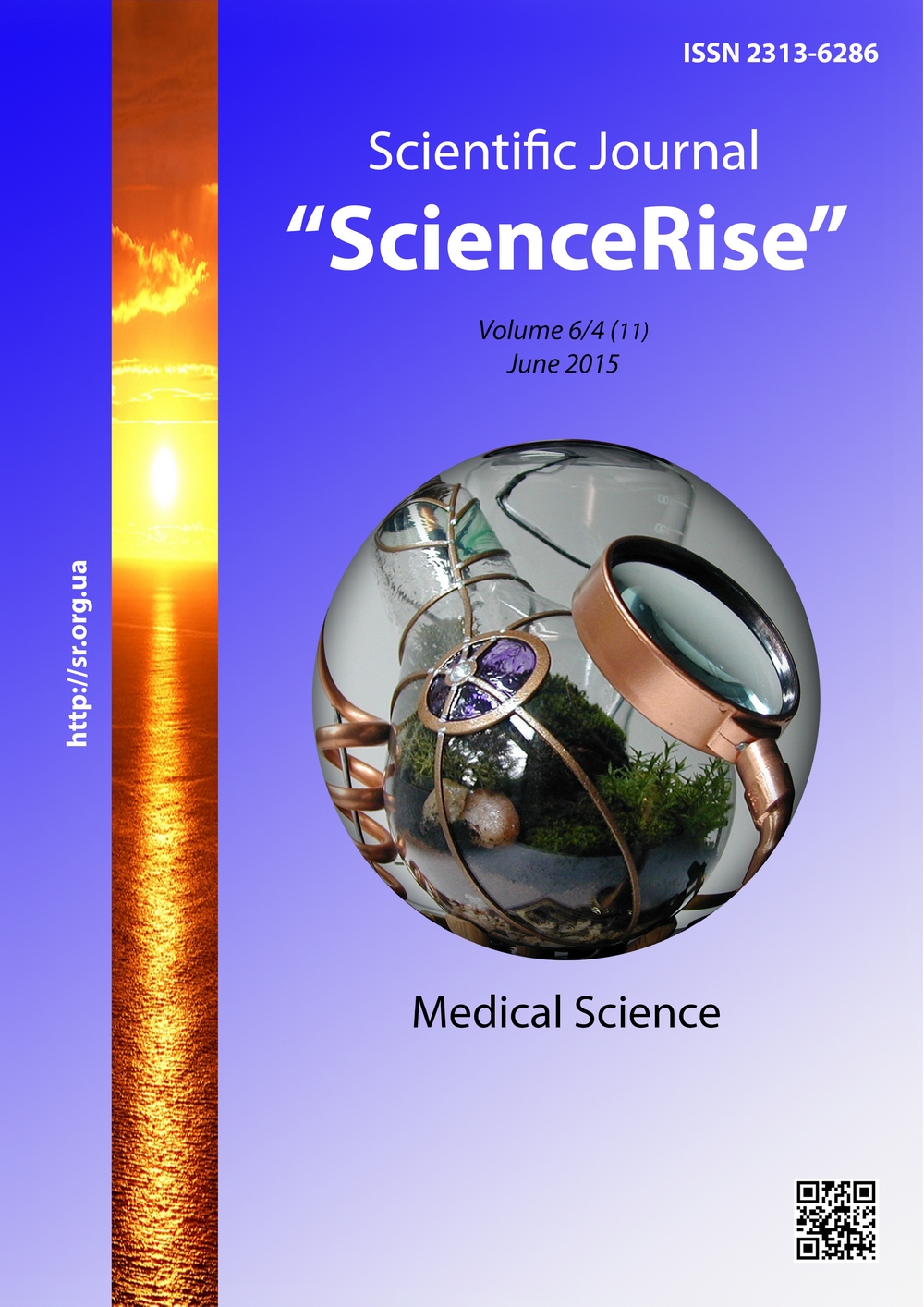Shutdown reactivity of platelets to adenosine diphosphate anr arachidoic acid and its prognostic value in patients with myocardial infraction with elevation of ST segment
DOI:
https://doi.org/10.15587/2313-8416.2015.45469Keywords:
antipleteled therapy, myocardial infraction, prognosis, reactivity of platelets, ADP, arachidoic acidAbstract
The double antiplateled therapy (DAT) with an acetylsalicylic acid (ASA) and clopidogrel is a standard therapy of patients with myocardial infraction but its efficiency in patients is different. Cardiologists of all over the world chose the causes of aforesaid for a long time.
Aim of research is to establish predictors of development of a high shutdown reactivity of platelets (HSTR) to ADP and AA (arachidoic acid) in patients with MFST (myocardial infraction with elevation of ST segment) and to evaluate its impact on the clinical course.
Materials and methods: It was examined 105 patients with an acute coronary syndrome with elevation of ST segment who underwent thrombolytic therapy. Examination of SRP (shutdown reactivity of platelets) to ADP and AA was carried out on analyzer of aggregation ALAT-2
Results: Values of SRP to AA >1,33 relative units (RU) an odds ratio (OR) 4.6; 95% of confidence interval (CI) 3.3-15.4, р<0,001) and for ADP >1,78 RU (OR 5.4; 95%CI 4.7-13.3, р<0,001) were considered high.
Survivability in patients with level SRP to AA >1,33 and to ADP >1,78 ВО was reliably lower than in patients with level <1,33 RU (р=0,042) і <1,78 RU (р=0,034), respectively. Multifactorial regressive analysis revealed an independent predictors of an increase of SRP to AA and ADP, among them the levels of estradiol, progesterone and its ratio in postmenopause (PM), duration of an arterial hypertension (AH) and postmenopause, pancreatic diabetes (PD)of the 2 type and female sex (all p<0,05).
Conclusions. In patients with MI an increase of SRP to AA and ADP is associated with a growth of risk of CEP development in 4,6 і 5,4 timesReferences
Steg, P. G., James, S. K., Atar, D., Badano, L. P., Lundqvist, C. B., Borger, M. A., Fox, K. A. (2012). ESC Guidelines for the management of acute myocardial infarction in patients presenting with ST-segment elevation. European heart journal; 33 (20), 2569–2619.
Price, M. J. (2011). Standard- vs High-Dose Clopidogrel Based on Platelet Function Testing After Percutaneous Coronary Intervention. JAMA, 305 (11), 1097–1105. doi: 10.1001/jama.2011.290
Stone, G. W., Witzenbichler, B., Weisz, G., Rinaldi, M. J., Neumann, F.-J., Metzger, D. C. et. al. (2013). Platelet reactivity and clinical outcomes after coronary artery implantation of drug-eluting stents (ADAPT-DES): a prospective multicentre registry study. The Lancet, 382 (9892), 614–623. doi: 10.1016/s0140-6736(13)61170-8
Tantry, U. S., Bonello, L., Aradi, D., Price, M. J., Jeong, Y.-H., Angiolillo, D. J. et. al. (2013). Consensus and Update on the Definition of On-Treatment Platelet Reactivity to Adenosine Diphosphate Associated With Ischemia and Bleeding. Journal of the American College of Cardiology, 62 (24), 2261–2273. doi: 10.1016/j.jacc.2013.07.101
Levine, G. N., Bates, E. R., Blankenship, J. C. et al. (2011). ACCF/AHA/ SCAI guideline for percutaneous coronary intervention: a report of the American College of Cardiology Foundation/American Heart Association Task Force on Practice Guidelines and the Society for Cardiovascular Angiography and Interventions. J Am Coll Cardiol, 58, e44–122.
Chirumamilla, A. P., Maehara, A., Mintz, G. S., Mehran, R., Kanwal, S., Weisz, G. et. al. (2012). High Platelet Reactivity on Clopidogrel Therapy Correlates With Increased Coronary Atherosclerosis and Calcification. JACC: Cardiovascular Imaging, 5 (5), 540–549. doi: 10.1016/j.jcmg.2011.12.019
Harrison, P., Mackie, I., Mumford, A., Briggs, C., Liesner, R., Winter, M., Machin, S. (2011). Guidelines for the laboratory investigation of heritable disorders of platelet function. British Journal of Haematology, 155 (1), 30–44. doi: 10.1111/j.1365-2141.2011.08793.x
Vorobeva, I. J. (2011). Sovremennie metodi otsenki functii trombocitov i ih clinicheskoe znachenie u bolnih s ostrim coronarnim sindromom [Modern methods of assessing platelet function and their clinical significance in patients with acute coronary syndrome]. Creative Cardiology, 33 (2), 252–263.
Aradi, D., Komócsi, A., Price, M. J., Cuisset, T., Ari, H., Hazarbasanov, D. et. al. (2013). Efficacy and safety of intensified antiplatelet therapy on the basis of platelet reactivity testing in patients after percutaneous coronary intervention: Systematic review and meta-analysis. International Journal of Cardiology, 167 (5), 2140–2148. doi: 10.1016/j.ijcard.2012.05.100
Breet, N. J. (2010). Comparison of Platelet Function Tests in Predicting Clinical Outcome in Patients Undergoing Coronary Stent Implantation. JAMA, 303 (8), 754. doi: 10.1001/jama.2010.181
Downloads
Published
Issue
Section
License
Copyright (c) 2015 Нонна Василівна Нетяженко

This work is licensed under a Creative Commons Attribution 4.0 International License.
Our journal abides by the Creative Commons CC BY copyright rights and permissions for open access journals.
Authors, who are published in this journal, agree to the following conditions:
1. The authors reserve the right to authorship of the work and pass the first publication right of this work to the journal under the terms of a Creative Commons CC BY, which allows others to freely distribute the published research with the obligatory reference to the authors of the original work and the first publication of the work in this journal.
2. The authors have the right to conclude separate supplement agreements that relate to non-exclusive work distribution in the form in which it has been published by the journal (for example, to upload the work to the online storage of the journal or publish it as part of a monograph), provided that the reference to the first publication of the work in this journal is included.

